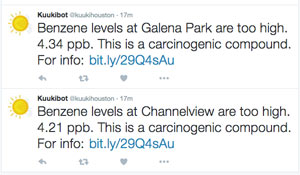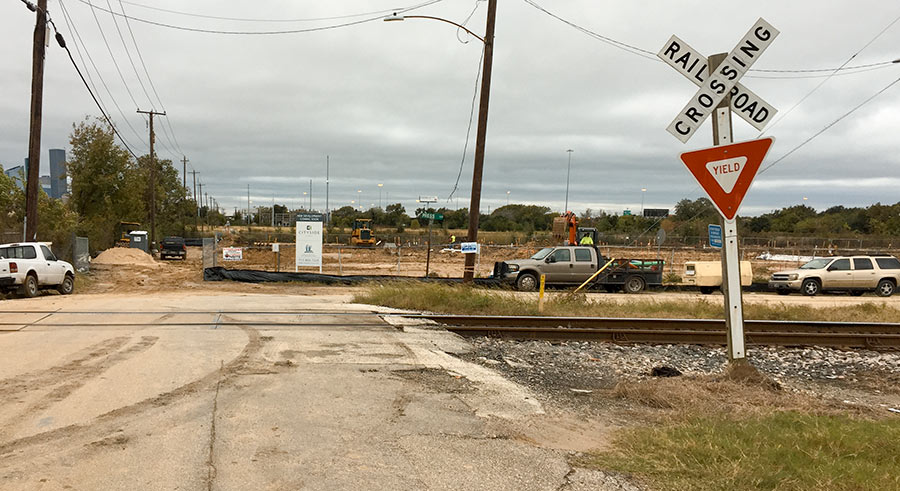FRIENDLY LOCAL BOT NOW CONTINUOUSLY TWEETING ABOUT HOUSTON’S ELEVATED AIR TOXIN LEVELS  Benzene levels have been relatively high near the TCEQ’s Channelview and Galena Park sensors today, according to the Twitter account of Kuukibot, the air-quality-obsessed automated program which Neethi Nayak, James Van Dyne, and some of the other civic-minded tech types at Sketch City launched last week with the Houston Air Alliance. (They were high yesterday, too — and the day before that, and the day before that.) Upon launch, Kuukibot’s feed immediately started filling up with short, sunny notes about levels of the carcinogen in those 2 neighborhoods; the lung-irritating 1,3 butadiene makes an occasional appearance in the feed as well, though few other places have shown up so far. The tweets, generated on the hour, don’t necessarily mean there’s a specific health hazard or legal violation occurring — just that the sum of the last 24 hours of TCEQ data for a particular sensor has crossed a certain threshold the team picked for each chemical as a reference point. The team is still working up public notes on the methodology, but according to Sketch City founder Jeff Reichman, the program wouldn’t be too hard to expand to most of the other chemicals (and other locations across the state) that the TCEQ monitors. [Previously on Swamplot] Capture of Kuukibot tweets: @kuukihouston
Benzene levels have been relatively high near the TCEQ’s Channelview and Galena Park sensors today, according to the Twitter account of Kuukibot, the air-quality-obsessed automated program which Neethi Nayak, James Van Dyne, and some of the other civic-minded tech types at Sketch City launched last week with the Houston Air Alliance. (They were high yesterday, too — and the day before that, and the day before that.) Upon launch, Kuukibot’s feed immediately started filling up with short, sunny notes about levels of the carcinogen in those 2 neighborhoods; the lung-irritating 1,3 butadiene makes an occasional appearance in the feed as well, though few other places have shown up so far. The tweets, generated on the hour, don’t necessarily mean there’s a specific health hazard or legal violation occurring — just that the sum of the last 24 hours of TCEQ data for a particular sensor has crossed a certain threshold the team picked for each chemical as a reference point. The team is still working up public notes on the methodology, but according to Sketch City founder Jeff Reichman, the program wouldn’t be too hard to expand to most of the other chemicals (and other locations across the state) that the TCEQ monitors. [Previously on Swamplot] Capture of Kuukibot tweets: @kuukihouston





So these folks defined “too high” as lower than what TCEQ, the law or science says it is, and now they’re busy telling people their own personal opinion about air quality, dressed up to look like real information? Wow, what a public service!
@Vonnegan: would you volunteer to have 4.5 pub of benzene pumped into your kids’ room everyday until they left for college? TCEQ raised the max on for benzene above what Mayor White and local air quality experts believed was safe not because the agency had confidence that the levels were truly safe but because the agency did not find the data on birth defects and childhood leukemia to be sufficient. Basically the tobacco defense.
“OSHA regulates levels of benzene in the workplace. The maximum allowable amount of benzene in workroom air during an 8-hour workday, 40-hour workweek is 1 ppm. Because benzene can cause cancer, NIOSH recommends that all workers wear special breathing equipment when they are likely to be exposed to benzene at levels exceeding the recommended (8-hour) exposure limit of 0.1 ppm. ”
.
“TCEQ benzene standard for public exposure three times higher than EPA and Houston”
.
http://www.cleanhouston.org/air/features/benzene.htm
.
Why someone would trust anything with the words “Texas Commission” in the 21st century or a state regulatory industry that has to keep it’s business happy over that of a scientific consensus is beyond me. You live in a state that would rather sue the EPA than comply.
Joel: Are we missing a connection here? Your quotes speak in terms of ppm, presumably “parts per million”, while the screenshots in the story above are getting (nearly) hysterical over ppb (parts per billion) measurements. Do we have a “little” thousand-fold disconnect here?
“TCEQ benzene standard for public exposure three times higher than EPA and Houston
In 2007, the TCEQ announced a new longterm effects screening level (ESL) standard for benzene. The level of acceptable public exposure to benzene was raised to 1.4 parts per billion (ppb), the “least protective†of the Clean Air Act risk range for toxicity and three times higher than the standard the Environmental Protection Agency (EPA) recommends. The ESL is the standard used in air permit reviews and the only benzene ambient air standard for Texas.
The EPA recommends 0.4 parts per billion (ppb), the “most protective†end risk range for benzene established by the Clean Air Act. The City of Houston released a report in 2008 explaining the various federal, state and city benzene standards. The report declared that the city standard is the same as the EPA standard for benzene at 0.4 ppb, sending a message that the standards for benzene set by theTCEQ did not provide adequate protection for Houston area residents.”
Joel’s quote of the indoor standard was a bit out of context. Above is the section regarding TCEQ allowing more than the EPA recommendation. I think the other issue is whether to measure using a one hour or eight hour standard. I believe that TCEQ has moved to the eight hour standard to help get numbers down from what the more sensitive one hour standard would show.